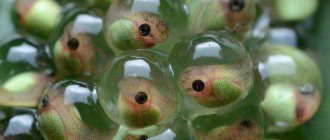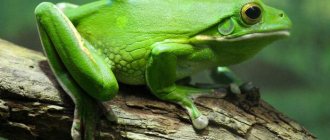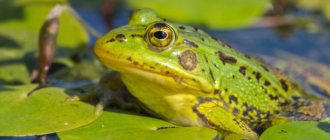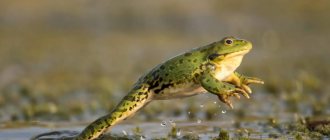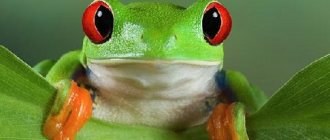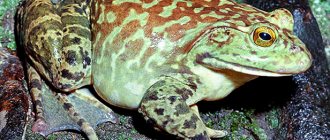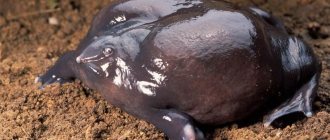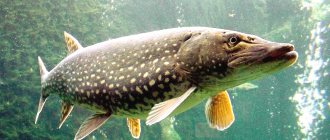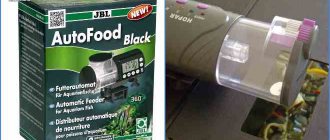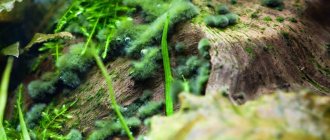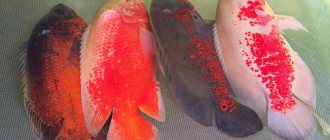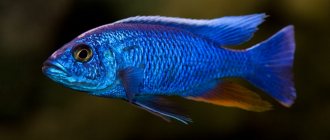Appearance of a grass frog
This animal is a small frog weighing approximately 23 g and a body length of 6 to 10 cm. The color is dominated by light brown tones.
There are dark spots on the sides and back, with a diameter of 1 to 3 mm. During the mating season, the male's throat acquires a blue tint, and the color of the entire body becomes lighter than usual. The female, on the contrary, becomes darker, with a marbled pattern on the abdomen and belly. The muzzle of the grass frog has a round shape. The hind legs are quite short relative to the body.
Interesting Facts
- She has very powerful, strong hind limbs, they help her jump high and hide from pursuit.
- Peter Pan syndrome means that tadpoles do not develop further and remain so for life.
- This species differs from its other closest relatives in the length of its hind legs and the shape of its head.
- While underwater, she is able to breathe through her wet skin, which helps her survive the winter.
- There are 6 species of these animals in total.
- If a frog is frightened, it can quickly change color.
Range and habitats of the grass frog
This frog lives throughout Europe, except for the south and central part of the Iberian Peninsula, the southern part of the Balkan Peninsula and southern Italy. The eastern border of the range is the Urals and Western Siberia.
Grass frog (Rana temporaria).
This frog also lives in the British Isles (it is noteworthy that the grass frog is the only frog species found in Ireland). The northern border of the range runs at the level of the Kola Peninsula and Scandinavia.
The grass frog is found mainly in forest-steppe and steppe zones. The presence of reservoirs for this species is necessary only during the breeding season.
Description
The grass frog is a medium-sized frog with a body length of 6-10 cm; occasionally larger specimens are found in the central part of its range.
The color is camouflage in nature. Due to the presence of chromatophores in smooth skin, it can vary in color from gray to brown. There are also often olive, yellowish or reddish individuals.
- Reptiles
- 72 facts about plants
- Animals of Siberia
- 35 facts about giraffes
- Animals of Crimea
- 36 facts about elephants
The back and sides are covered with small dark spots. There is a noticeable dark V-shaped spot on the neck. There are transverse stripes on the hind legs. The ventral side is whitish, cream or grayish with brown or black speckles.
The head is small. The muzzle is rounded and short. The pupils of the eyes are located horizontally. There is a swimming membrane between the fingers.
During the mating season, males have a throat that turns blue. In addition, during the mating period, the male is lighter, grayish in color, the female, on the contrary, is browner, often reddish-brown. The bottom has a dark marble-like pattern.
Similar species
It differs from the sharp-faced frog in its smaller internal calcaneal tubercle, belly color and snout shape. It differs from the frog in having shorter hind limbs and the presence of internal resonators in males. Geographically isolated from Asia Minor, Central Asian, Siberian and Far Eastern frogs. It differs from green frogs in its dark temporal spot.
Lifestyle of the grass frog
The frog is active mainly at dusk and at night. During the day, the animal prefers to lie down in fallen leaves, under stumps and stones.
The grass frog is one of the most common in Europe.
Grass frogs spend almost the entire time of their life cycle on the surface of the earth, moving to water bodies only during the mating season. This frog constantly changes habitats, moving over distances of up to 1 km per day. On land, the grass frog moves in small jumps. For most of the year, these frogs stay alone, forming clusters only during the breeding season.
In spring, the onset of appearance and activity of frogs greatly depends on weather conditions and the region. Usually the first grass frogs begin to appear in the first ten days of March. The active season lasts about 7 months and ends around October-November. These frogs spend the winter on land, hiding in piles of leaves, rotten stumps and even in the burrows of some rodents.
In males during the mating season, the body color becomes lighter and the throat becomes blue.
Lifestyle
Adult frogs are solitary by nature and are found in groups only in reservoirs during the mating season. In the summer season they can often be found in places such as:
- river banks;
- green meadows;
- forests;
- swamps;
They are also regular guests in home areas, gardens, flower beds, front gardens and vegetable gardens with abundant herbal vegetation.
In the summer, they are active at night, and during the day they hide in dense and tall vegetation, but they can do the opposite, crawl out of the shelter and bask in the sun.
From the beginning of March to the end of May, you can watch them travel to the water. The males will help us with this; they sing mating serenades to their lovers.
From November to February, she tries to find a moist and safe place, usually these places are composts, or even hide under water.
Note! The position in which she spends the winter evokes, at least for us, a friendly smile. She tucks her hind legs to her stomach and covers her head with her front legs .
Nutrition of grass frogs
At different stages of a grass frog's life, its diet varies. Adults are predators and eat various invertebrates such as flies, worms, and snails. When hunting, they use a sticky long tongue. During the mating season, frogs almost completely stop consuming food.
Tadpoles of this species are herbivores, feeding on detritus, algae and some other aquatic plants. However, sometimes tadpoles do eat other animals.
Grass frog tadpoles are herbivores, but some may consume small animals.
Natural enemies
For adult individuals of this frog, the enemies are snakes (common snake, viper), birds (magpies, crows, blackbirds, jays and shrikes and others), predatory fish (pike, catfish, perch).
Among the animals, the fox, raccoon dog, marten, ermine, mink, badger, and otter feed on grass frogs. Sometimes a grass frog attracts the attention of a brown bear, wolf, or wild boar.
Some birds of prey that feed on frogs in years when there are few mouse-like rodents prey on larger grass frogs.
Even the eggs of these amphibians, covered with jelly-like shells, are not very edible, but they are also hunted by planarians, insects, larvae of other amphibians, etc. Tadpoles are hunted by all aquatic predators.
Reproduction of grass frogs
These frogs begin to mate within a week of emerging from hibernation. Frogs spawn mainly in bodies of water with running or standing water with abundant shrub vegetation along the banks. Spawning lasts up to a week, after which the females leave the reservoir a little earlier than the males.
This type of frog carries out group laying of eggs, in which up to several dozen pairs participate.
Moreover, the number of eggs in the clutch of one female individual directly correlates with the size and age of this individual. Thus, a 3-year-old female with a body length of 62 mm lays approximately 930 eggs, while a 6-year-old female with a body length of 87 mm lays about 3660 eggs. The size of the eggs also varies - the larger and older the female, the larger the diameter of the eggs.
Grass frogs spawn in ponds.
The timing of the appearance of tadpoles from eggs depends on the geographical location of the habitat. So, in the north of Russia, metamorphosis occurs after 20 - 60 days, and in the south after about 90 days. The mortality rate at this stage of development is quite high. The number of surviving fingerlings is only 4% of the original number of eggs.
Development
Many people know that in order for a frog to reach adulthood, it must go through several stages before it can emerge from the water.
— Stage 1
After the female lays a clump of eggs, it can contain from 654 to 1567 eggs, and the male fertilizes them, several days pass and tadpoles begin to grow in them. Their silhouette can be observed through the transparent walls of each individual egg.
— Stage 2
After 10 - 12 days, the tadpoles peck through the thin walls of the eggs and enter the aquatic environment, breathing under water with formed gills.
Another 13 - 15 days will pass and their front and hind legs begin to grow, the tail disappears. Their gills develop into lungs and they can emerge from the water to further develop. Their dimensions do not exceed three centimeters.
— Stage 3
After the stages described above, it turns into an adult, fully formed individual. The total development time from a tadpole to a small frog will take from 50 to 90 days. The development of tadpoles is strongly influenced by water temperature.
Internal structure
Adult amphibians are predators, feeding on various insects and other invertebrate animals; some aquatic amphibians catch small vertebrates.
Digestive system
The digestive system begins with a large oropharyngeal cavity, at the bottom of which the tongue is attached at the anterior end. When catching prey, the tongue is thrown out of the mouth, and the prey sticks to it. Streams of salivary glands open into the oropharyngeal cavity. Their secretion moistens the cavity and food, making it easier to swallow prey. On the upper jaw there are small conical teeth that serve only to hold prey. Food moistened with saliva enters the esophagus and then into the stomach. The glandular cells of the stomach walls secrete the enzyme pepsin, which is active in an acidic environment (hydrochloric acid is also released in the stomach).
Partially digested food moves to the duodenum, into which the bile duct of the liver flows. Pancreatic secretions also flow into the bile duct. The duodenum quietly passes into the small intestine, where nutrients are absorbed. Undigested food remains enter the wide rectum and are expelled through the cloaca.
Respiratory system
The frog breathes through its lungs and through its skin. On the walls of the paired sac-like lungs there is an extensive network of blood vessels. When the frog opens its nostrils and lowers the bottom of the oropharyngeal cavity, air enters the latter.
Then the nostrils close with valves, the bottom of the oropharyngeal cavity rises, and air passes into the lungs. Exhalation occurs due to the action of the abdominal muscles and the collapse of the pulmonary walls.
Circulatory system
The heart of adult amphibians has three chambers - two atria and one ventricle. An arterial cone with a longitudinal spiral valve inside extends from the ventricle, which distributes arterial and mixed blood into different vessels. The right atrium receives venous blood from internal organs and arterial blood from the skin, i.e. mixed blood gathers here. The left atrium receives arterial blood from the lungs. Both atria contract simultaneously and blood flows from them into the ventricle. Thanks to the longitudinal valve in the arterial cone, venous blood flows to the lungs and skin, mixed blood flows to all organs and parts of the body except the head, and arterial blood flows to the brain and other organs of the head.
Amphibians have two circuits of blood circulation, but they are not completely separated due to a single ventricle. In a large circle, blood flows from the ventricle to all organs, and from them through the veins it returns to the right atrium. In the pulmonary circle, blood flows from the ventricle to the lungs and skin, and from there, enriched with oxygen, it returns to the left atrium.
Excretory system
The excretory system is represented by two kidneys located on the sides of the sacral vertebra. The kidneys contain glomeruli, in which harmful breakdown products and some valuable substances are filtered from the blood. During the flow through the renal tubules, valuable compounds are reabsorbed, and urine flows through two ureters into the cloaca and from there into the bladder. After filling the bladder, the muscles of its walls contract, urine is discharged into the cloaca and thrown out.
Nervous system
The brain has the same sections as those of fish. The forebrain is more developed, divided into two hemispheres.
The cerebellum is small, which is explained by a sedentary lifestyle and monotony of movements.
In the eyes of adult amphibians, movable eyelids (upper and lower) and a nictitating membrane are developed; they protect the cornea from drying out and contamination.
Metabolism
Security status
At any stage of development, the grass frog has many natural enemies who are not averse to feasting on it. For example, the life of an adult can be threatened by vipers, grass snakes, storks, crows, owls, magpies, eagle owls, catfish and pike. Mammals such as wolves, foxes, minks and weasels also pose a threat to mature amphibians. In addition, newts, ducks, terns, mallards and godwit consider frog eggs to be their food. Tadpoles are eaten by swimming beetles, field thrushes, rollers, etc.
At the beginning of the last century, there were much more of these frogs than today. The reason for the sharp reduction in the number of individuals lies in the pollution of the natural environment, especially water bodies, with detergents and pesticides. Many adult frogs die on highways. A huge number of them are caught and used as experimental animals. Deforestation has led to the complete disappearance of frogs in some areas of their habitat.
Contents indoors
You can provide proper care to an amphibian at home. To do this, first of all you need to purchase a large aquaterrarium with a capacity of at least 50 liters. After you fill the container with water, place non-sinking “islands” made of foam or wood into it. These areas are needed so that the animal has the opportunity to get onto land when necessary. Provide the surface of the “islands” and the bottom of the aquarium with water stems and leaves. The presence of vegetation is necessary for the frog to hide from light sources.
Since, living in the wild, the amphibian does not have any fancy requirements for living conditions, it will also be easy to keep it in a house or apartment. Change the water in the aquarium at least once a week by 1/3. The fluid must be completely replaced once a month. The aquarium does not need to be equipped with heating and lighting.
You can feed an adult frog with flies, cockroaches, bloodworms, crickets and other insects that amphibians feast on while in nature. From time to time, give your pet finely chopped pieces of raw meat. Young frogs should be fed lettuce and nettle leaves. The last of these plants must be doused with boiling water before use.
Sexual dimorphism
Permanent and seasonal sexual dimorphism is a characteristic characteristic of many amphibians, including some species of frogs. Some poison dart frogs are characterized by enlargement of the finger pads of males, which is used by the amphibians when tapping on the ground and helps to actively attract females. Males of some species are distinguished by greatly enlarged eardrums. Seasonal dimorphism is caused by the presence of so-called gonadotropic hormones in the animal’s body.
This is interesting! There are species in which, upon visual inspection, it is impossible to determine their gender in accordance with only one characteristic, so it is necessary to compare several morphological characteristics at once.
One of the most striking and pronounced sexual characteristics that are characteristic of male frogs is the formation of nuptial pads as a response to changes in the hormonal levels of the testes.
In the frog, such pads are formed on the lower part of the forelimbs, on the fingers and near the mouth, due to which all mature males remain in a mated state with the female even when there is strong movement of water or attack by other animals.
